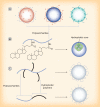Application of polysaccharides for surface modification of nanomedicines
- PMID: 23323561
- PMCID: PMC3578296
- DOI: 10.4155/tde.12.105
Application of polysaccharides for surface modification of nanomedicines
Abstract
Polysaccharides have been used in various biomedical applications due to availability and biocompatibility. In particular, polysaccharides have gained increasing interest in the development of functional nanomedicines as a component to provide a stealth function, improve interactions with target tissues or enable environment-responsive drug release. This review discusses recent advances in nanomedicine engineering based on polysaccharides with a specific emphasis on the rationale, applications and the remaining challenges.
Figures


Similar articles
-
Polysaccharide-based nucleic acid nanoformulations.Adv Drug Deliv Rev. 2013 Aug;65(9):1123-47. doi: 10.1016/j.addr.2013.05.002. Epub 2013 May 13. Adv Drug Deliv Rev. 2013. PMID: 23680381 Review.
-
Chitosan, hyaluronan and chondroitin sulfate in tissue engineering for cartilage regeneration: a review.Carbohydr Polym. 2012 Jul 1;89(3):723-39. doi: 10.1016/j.carbpol.2012.04.057. Epub 2012 May 4. Carbohydr Polym. 2012. PMID: 24750856 Review.
-
Colon targeted delivery systems: review of polysaccharides for encapsulation and delivery.Crit Rev Food Sci Nutr. 2005;45(4):251-8. doi: 10.1080/10408690490478091. Crit Rev Food Sci Nutr. 2005. PMID: 16047493 Review.
-
Polysaccharide-based nanoparticles for theranostic nanomedicine.Adv Drug Deliv Rev. 2016 Apr 1;99(Pt A):70-84. doi: 10.1016/j.addr.2015.11.015. Epub 2015 Nov 27. Adv Drug Deliv Rev. 2016. PMID: 26639578 Free PMC article. Review.
-
Recent advances in hyaluronic acid-based nanomedicines: Preparation and application in cancer therapy.Carbohydr Polym. 2022 Sep 15;292:119662. doi: 10.1016/j.carbpol.2022.119662. Epub 2022 May 27. Carbohydr Polym. 2022. PMID: 35725165 Review.
Cited by
-
Polymeric Nanoparticles for Drug Delivery.Chem Rev. 2024 May 8;124(9):5505-5616. doi: 10.1021/acs.chemrev.3c00705. Epub 2024 Apr 16. Chem Rev. 2024. PMID: 38626459 Free PMC article. Review.
-
Nanoparticle characterization: state of the art, challenges, and emerging technologies.Mol Pharm. 2013 Jun 3;10(6):2093-110. doi: 10.1021/mp300697h. Epub 2013 Mar 21. Mol Pharm. 2013. PMID: 23461379 Free PMC article. Review.
-
Multimodal Nanocarrier Probes Reveal Superior Biodistribution Quantification by Isotopic Analysis over Fluorescence.ACS Nano. 2020 Jan 28;14(1):509-523. doi: 10.1021/acsnano.9b06504. Epub 2020 Jan 7. ACS Nano. 2020. PMID: 31887006 Free PMC article.
-
Breaking barriers: Smart vaccine platforms for cancer immunomodulation.Cancer Commun (Lond). 2025 May;45(5):529-571. doi: 10.1002/cac2.70002. Epub 2025 Feb 3. Cancer Commun (Lond). 2025. PMID: 39901621 Free PMC article. Review.
-
Overcoming Multidrug Resistance in Bacteria Through Antibiotics Delivery in Surface-Engineered Nano-Cargos: Recent Developments for Future Nano-Antibiotics.Front Bioeng Biotechnol. 2021 Jul 8;9:696514. doi: 10.3389/fbioe.2021.696514. eCollection 2021. Front Bioeng Biotechnol. 2021. PMID: 34307323 Free PMC article. Review.
References
-
- Matsumura Y, Maeda H. A new concept for macromolecular therapeutics in cancer chemotherapy: mechanism of tumoritropic accumulation of proteins and the antitumor agent smancs. Cancer Res. 1986;46(12 Pt 1):6387–6392. - PubMed
-
- Kao YJ, Juliano RL. Interactions of liposomes with the reticuloendothelial system. Effects of reticuloendothelial blockade on the clearance of large unilamellar vesicles. Biochim. Biophys. Acta. 1981;677(3–4):453–461. - PubMed
-
- Patel HM, Moghimi SM. Serum-mediated recognition of liposomes by phagocytic cells of the reticuloendothelial system – the concept of tissue specificity. Adv. Drug Deliv. Rev. 1998;32(1–2):45–60. - PubMed
Publication types
MeSH terms
Substances
Grants and funding
LinkOut - more resources
Full Text Sources
Other Literature Sources
